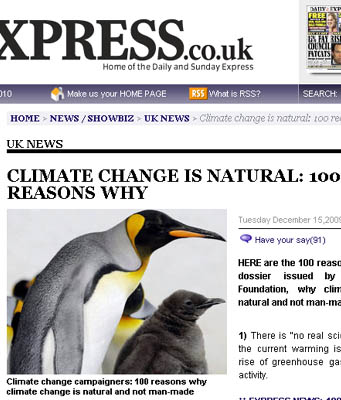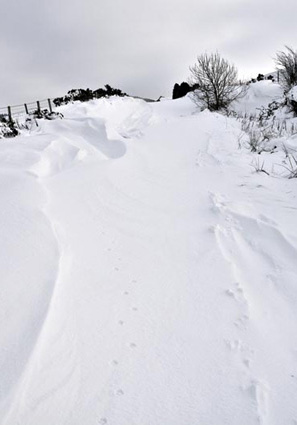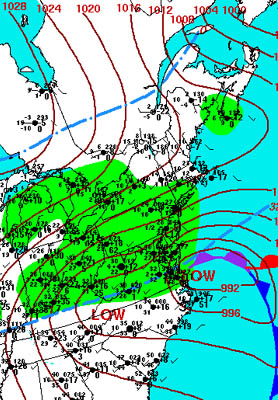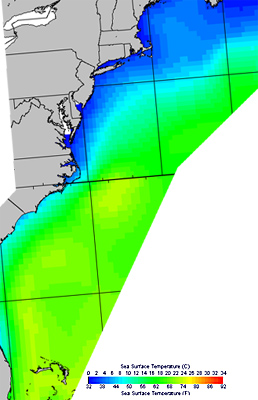BACK
TO WEATHER-BLOG MENU
New!
Fine Art Prints & digital images for sale-
Welsh Weather
& Dyfi Valley landscapes Slide-Library - Click HERE
 CLIMATE WARS
CLIMATE WARS
It
has become akin in some ways to the evolution vs. creation debate.
On
the one hand is established science. On the other, there is a diverse
body of opinion and belief with a diverse range of
"alternative" explanations, the only thing held in common being the
assertion that the 27 billion tonnes of carbon dioxide that we add to
the atmosphere every year from burning fossil fuels is harmless.
Why
the whole 30+ years climate debate has gone up a gear lately is an
interesting subject that no doubt history will still be chewing over in
another 30 years. A few years ago on here I was lambasting
the
media for attempting to blame everything in the Natural Disasters
Department on global warming - which at the time was certainly a
frequent observation in the press.
More
recently, like a pendulum, much of the
media has swung in the opposite direction and the papers are attempting
to tear the science apart - and since that's a bit technical,
attempting to
tear apart the scientists and their institutions instead. The debate
has become unpleasant, spite-ridden, focussing on attempts at
character-assassination, misquotation and manipulation of the words of
others as the soundbites bounce around the echo-chamber from one outlet
to another.
The
clear observation from where I am sitting is that the science itself
remains unchanged, despite the numbers of things with "gate" on the
end that are being cooked up on a weekly basis, most of which have been
soundly debunked. And what of the genuine errors uncovered? A good
number of Himalayan glaciers ARE retreating
despite the silly date that got into page 493 of the WG2 section of
the IPCC's 2007 report. What do people expect? An error is found in a
report and the glaciers all immediately start to advance again? To turn
the 2035 flaw into a statement like "The glaciers in the Himalayas are
NOT retreating"
is to make an even more fundamental error. One might think that people
would grasp that the laws of physics do not respond to public opinion.
So what's going on?
The
blatantly obvious political battles are easy to identify - for example,
the run-up
to COP 15 - the Copenhagen conference - would guarantee a lot of noise
from those organisations rigidly opposed to any deviation from Business
As
Usual. I do not think the release of the carefully-prepared archive of
CRU emails was a coincidence of timing. It was a political act, with
sabotage being a not-unreasonable guess as to its intended goal.
One has to ask, however, this rather pertinent question: if the science
behind the fact that carbon dioxide is a forcing agent that causes
warming (first
published: 1896, with thousands of supporting papers since) is so
flawed, why was all this skullduggery necessary?
Meanwhile,
a cold UK winter reminiscent of some of those of the late
1970s and 80s is guaranteed to bring newspaper headlines such as "SO
THIS IS GLOBAL WARMING??!!?" - this happened in the 2008-9 winter too,
another one in which there was some very cold weather. Likewise, the
eastern USA saw "Snowpocalypse" and "Snowmageddon" this past few
months. On
a thousand Internet Forums right now there are
apoplectic people, sparks flying from their keyboards: "THEY SAID THE
ICECAPS WOULD MELT. THEY HAVEN'T. THEY SAID THERE WOULD BE NO MORE
SNOW. WELL I CAN TELL THEM IT'S THREE FEET DEEP". And so on and so
forth. How
can such cold weather be possible, if we are supposed to be warming?
That's a fair question, so let's
have a more in-depth look.

L
- They told me it was getting warmer
and just look at it! I want my money back!!!
In
scientific terms, such arguments as those in capitals above are pure
straw men - setting up a
false
premise and shooting it down again is a favourite if not entirely
honourable debating tactic as
old as the hills. I have followed the published literature on climate
for a long time and I can confidently state that there is not one
peer-reviewed paper that predicts the total loss of the Greenland or
Antarctica icecaps now or in fifty years' time - their total melting
would take many
centuries and it will not be a linear process. Likewise, there is not
one paper I have seen that forecasts the
abolition of cold weather in winter by 2010, 2020 or 2030. If such
things have been said, they have been said by sensationalist media
outlets,
completely immune to the pre-publication review procedures that screen
out many errors from scientific papers. Thus, a single, 1000-word
newspaper article can contain ten times the number of errors found in
the 2800-page IPCC AR4 report, not that anybody seems to mind!
Let's
get this into some kind of perspective here. Climate models suggest
that global average temperatures will (under a Business As Usual
scenario) rise by 3-6C over the next 100 years or so, with a much
greater warming at high latitudes. OK then - gameplay time - let's give
the Arctic a
6-12C imaginary warming right now. Over much of the Greenland
interior on a February morning, the temperature will be
between -20 and -30C. Knock even 12C off that and it's -8 down to -18C,
which is still bloody cold in my books! Let's continue playing and give
the UK the full +6 degree
imaginary warming. We have had severe frosts this winter with minima
between -10
and -20. So with +6 we still have the potential for -4 to -14 and
that's with the full warming, a hundred years from now. The message is
simple: winters far into the future may be less cold, but spells of
cold weather are not going to go away just yet! They will still occur
when the correct arrangements of the jetstream and high and low
pressure systems are in place.
So
far, in fact, the amount of increase in average global temperature has
been a little below 1C. We are right on the lower rungs of the ladder
that stretches up above us into our uncertain future.
HOW DOES SNOWMAGEDDON FIT INTO A
SUPPOSEDLY WARMING WORLD?
As
a severe
weather enthusiast, I've done a bit of reading-up on these and it's
interesting to see how they formed.
 These
were
classic Nor-easter storms, as the synoptic chart for February 6th
shows (L). They occur when low pressure systems deepen over the
eastern, Atlantic coast of the USA, causing a long-fetch NE airflow in
off the sea and into the cold Eastern states - and that's the key.
These
were
classic Nor-easter storms, as the synoptic chart for February 6th
shows (L). They occur when low pressure systems deepen over the
eastern, Atlantic coast of the USA, causing a long-fetch NE airflow in
off the sea and into the cold Eastern states - and that's the key.
We
have a similar phenomenon in the UK that brings prolonged rain - the
Warm Conveyor. In our case, this is a long-fetch SW airflow that comes
in from the mid-Atlantic and runs into our hilly western side. The last
significant one, in November 2009, brought flooding right up the
western seaboard, and in the Lake District, record-breaking rainfall
and disastrous flooding at great personal and economic cost.
To have heavy prolonged rain or snow, the air coming into your area has to be carrying plenty of moisture. Whether it's rain or snow is down to having the right temperatures through the air profile, and as we know over here it doesn't have to be -15 before it will snow - in fact the phrase "it's too cold for snow" is something that one often hears. No - it's that moisture that is critical in both cases.
How
would even slightly increased temperatures influence things here? Well,
there
are two issues, both of which are highly sensitive to any temperature
increase. Firstly, if you warm the sea surface up, what happens?
Well, anybody who has noticed steam rising from a warm bath will have
seen evaporation occurring, and the warmer the water, the greater the
rate of evaporation. As is the case with the laws of physics, this
applies whether it's a warm ocean or a steaming hot bath.
Secondly,
amongst the properties of warmer air is one critical one in this
context: warmer air can carry more moisture. It can pick it up over the
ocean and transport it hundreds of
miles. How does this work? It's the nature of the equilibrium between
the water (the liquid phase of H2O) and its vapour (the gaseous phase
of H2O). In air, these two phases exist in dynamic equilibrium, in
which the gaseous molecules are combining and condensing to form
liquid, and simultaneously the liquid molecules are evaporating to form
gas. These processes are occurring at the same rates, so that the
proportions of liquid and gas remain the same. Now, if you alter things
by warming that
air up, obviously you warm its contents including the water: then the
water molecules, both liquid and gas, have more kinetic energy: in turn
this hinders the condensation of gas-phase into liquid and helps the
liquid-phase to evaporate. This imbalance is addressed by increasing
the concentration of liquid-phase water until equilibrium is once again
reached at a higher equilibrium concentration - or vapour pressure as
it's usually known.
Now,
develop a strong low just off the East coast of the USA, with a high
pressure area over central Canada, and what happens if the sea and the
air over it are just a bit warmer?
 Sea temperatures can be
examined at sites such as http://www.oceanweather.com/data/
where the warm Gulf Stream current can easily be seen, traveling up
the coast as far as Cape Hatteras in North Carolina and then veering in
a more NE direction. The coast to the north (i.e. from Virginia up to
Maine) is hugged by the cold Labrador Current, but less than a couple
of hundred miles off Rhode Island and we have pleasantly warm water of
as much as 20C or more even at this time of year.
Sea temperatures can be
examined at sites such as http://www.oceanweather.com/data/
where the warm Gulf Stream current can easily be seen, traveling up
the coast as far as Cape Hatteras in North Carolina and then veering in
a more NE direction. The coast to the north (i.e. from Virginia up to
Maine) is hugged by the cold Labrador Current, but less than a couple
of hundred miles off Rhode Island and we have pleasantly warm water of
as much as 20C or more even at this time of year.
Warm
up that water, warm the air above it, even by a little bit, and even
more moisture will be picked up and transported towards the coast. Slam
that warm moist air feed into the cold Arctic air circulating the
Canadian High and hey presto! Snowmageddon!
So therein lies the
problem for the residents of these states. The warming does NOT make it
too warm for snow, but instead it makes the atmosphere in the critical
area out over the ocean moist enough for lots and lots of snow when
that air moves inland and meets the cold. As with our record-breaking
Lake District flooding, it is very tempting to suggest that these
events are part of a trend that is emerging from the noise.
However, there's an old
British saying: "Two swallows do not a Summer make". This means that
two events, even though they appear to be indicating something, are
insufficient as yet to be absolutely conclusive on their own. Climate
models predict such events to become more frequent and the basic laws
of physics predict that they will occur in a warmer system. There will
come a point when a clear signal in terms of frequency of severe
rain/snowfall events does emerge from the noise, but
because climate operates on multidecadal timescales, you would need to
look at a minimum of 30 years to make an authoritative conclusion based
on observations alone.
BUT
WHAT ARE TRENDS?
That trends in climate
tend to have greater significance over longer timespans can be
difficult to get one's head around. But this is an excellent analogy
that should help (with acknowledgement to John Russell on Skeptical
Science - link below):
You're
standing on the beach, watching the waves, and trying to work out
whether the tide's coming in or going out. Now, you can see that some
waves look bigger, some smaller, some coming nearer to your feet and
some further away (this being the noise), but after 25 waves in just
under a minute it's not clear what's occurring either way: the noise
(waves) is hiding the trend (tide) because the time period is
insufficient for a statistically significant trend to emerge. So you
sit in your deckchair by the water's edge for half an hour, during
which 750+ waves come ashore, and at the end of that time you find
yourself sitting in six
inches of water. You have discovered the statistically significant
trend, which in this case is that the tide is coming in!
That's
why 30 year+ timespans are used in determining significant climate
trends: although the beach analogy describes one example of a trend
emerging from the noise, in the case of climate the trend is much more
subtle than the tide coming in and the noise much more intense. A
favourite contrarian gambit for some time now has been to plot
temperatures
starting with 1998 (an anomalously warm year with the most intense El
Nino of the 20th Century), because that neatly generates a flatline or
an apparent slight cooling, depending what year you end on. But due to
the short
time period - well under 30 years - it does not tell you anything
statistically significant - it is a pointless exercise and a practise
known as cherrypicking, taking the big positive piece of noise that was
1998 as the starting-point. Fail.
Of
course, a flat calm day with no swell would let you watch the tide
trickle up the sand and you could make your trend conclusion in much
less time - but as a consequence of weather, the highly variable El
Nino/La Nina cycle, variations in aerosols including volcanic dust and
so on and so forth, you don't get the equivalent of a calm day with no
swell in global climate.
LOOKING AHEAD.....
Looking
ahead - I
think that's one of the biggest problems with climate change and its
public image. It always seems to be about things happening several
decades away - and the worst predictions concern the later decades of
this century, so that they could only be witnessed by a small
percentage of those of us who engage in the debate right now. But
already we are seeing a hint here, a hint there, that there are unusual
things going on. Reading the literature leaves one with the strong
conviction that there will surely come a point where, to all but the
most diehard political activists, it can no longer be shrugged off,
dismissed as a leftist conspiracy to raise taxes or whatever.
Unfortunately, in financial terms by that point it could make the
banking bail-out look like the bargain of the year!
The
problem of the PR disaster - over-egged media alarmism, leading people
to expect total chaos right now and, in the general absence of that,
leaving them often feeling rather short-changed, is something that the
media need to reflect on. But swinging to the opposite extreme does not
help. It is taking the easy way out. Nobody wants to be told their
lifestyle is harmful to the general future prospects for civilisation:
in contrast it's very easy (and in this case intellectually lazy and
downright irresponsible) to tell people exactly what they want to hear.
Of
course, there is another very good reason for a transition towards a
low-carbon economy: that concerns the future availability of fossil
fuels. We are at or very close to the peak in conventional crude oil
production - i.e. transport fuel for most of us. Gas will peak sometime
this century, coal sometime this or next. With the latter two, the
question is probably more along the lines of how much we want to leave
for future generations; with oil we are already seeing problems both in
the global economy and within the oil sector due at least in part to
oil price volatility since 2007. We will continue to use fossil fuels
but we need to phase in alternatives steadily: the alternative is to
walk blindly into a "supply crunch" event with profound and severe
consequences for most of us. Perhaps, though, the answers lie in
carrots, not sticks. The business and employment opportunities that
exist in the development of a lower-carbon economy are vast:
furthermore, the value of the fossil fuels as chemical feedstocks is I
would suggest likely to go up significantly through time.
So:
avoiding an oil supply-crunch, generating extensive new business and
employment opportunities and increasing the value of the remaining
fossil fuels PLUS avoiding the worst climate-related issues in the
latter part of this century looks - to me, anyway, like a win-win-win
situation. Whether we actually achieve all of that will be a matter for
history to decide.
To
finish with, here are a few climate-related sites I like. Some are more
concerned with the science, some with the politics, but all are
worth a read, and all link to other sites of interest.
| REALCLIMATE | DEEPCLIMATE | CLIMATE PROGRESS |
| TAMINO'S OPEN MIND | DELTOID | SKEPTICAL SCIENCE |
depend on science and technology. We have also arranged things
so that almost no one understands science and technology.
This is a prescription for disaster.
Carl Sagan, 1995
BACK TO WEATHER-BLOG MENU New! Fine Art Prints & digital images for sale- Welsh Weather & Dyfi Valley landscapes Slide-Library - Click HERE |